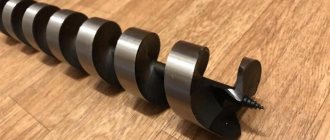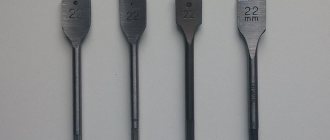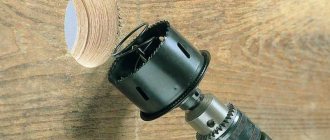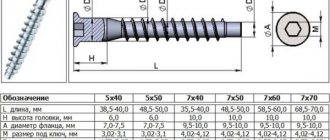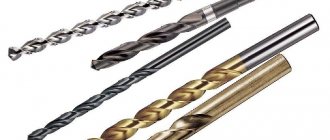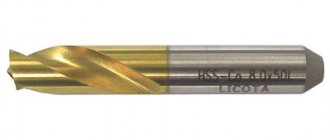Changed and forgot | 11/16/2015
When the need arises to make holes in wooden blanks, the question always arises: how and with what tool will it be easier, faster and more convenient to do this. Of course, in today's construction markets there are a huge number of drills available that can make different types of holes. However, their extraordinary cleanliness and complete absence of chips can be achieved only by using so-called Forstner drills for wood.
The history of the drill
The inventor of such a tool was the famous American gunsmith Benjamin Forstner. His woodworking drill was first patented in 1874 and brought him unprecedented success and profit. Forstner drills are still manufactured to this day, but since that time many other types of similar tools have appeared. In some cases, the appearance of the samples is only vaguely reminiscent of the first invented drill, but they all continue to work on the same principle.
Operating rules
They are designed to make work easier and prevent injuries:
- The drill must be installed accurately. To do this, the centering point is pressed into the wood until it touches the outer edge. The nozzle operates at low speeds up to 1800 rpm. Drilling should begin at a minimum rotation speed of 800 rpm;
- The operating speed directly depends on the hole diameter. The larger it is, the less speed it needs to be drilled. This helps maintain optimal temperature on the working part of the tool;
- The Forster drill can be equipped with a depth limiter. This is a useful option designed to record the cutting depth, as well as increase safety measures during work;
- Sometimes the thickness of the material does not allow you to fully use the functionality of the tool. If the sheet of wood is too thin, the centering tip can pierce through it, then two drills are used. The first sets the direction of movement. The second has a sharpened edge. With its help, the required hole thickness is selected.
Forstner drill. What is it used for?
The Forstner wood drill bit was originally developed for the purpose of making flat-bottomed, blind-type holes in soft and hard woods. Now it is also used when working with MDF, fiberboard or chipboard, as well as their various modifications.
The drill is used mainly in furniture production, for example to obtain:
- blind recesses for door hinges, locks, threaded and eccentric couplers;
- holes of great depth when installing fittings and the need to obtain neat and even edges.
In other applications, the drill bit can be used for installing window openings, door locks, electrical wiring, and plumbing and electrical work.
A Forstner drill for wood makes it possible to obtain ideal recesses with a flat bottom, missing the outer edge by only 1-2mm. Drills are designed for installation in electric or hand drills with a speed of 400 to 1400 revolutions per minute, depending on the diameter.
So, the main advantages of such drills are:
- increased fineness and speed of the drilling process due to the centering head;
- compliance with clear cut geometry and specified dimensions;
- availability of a wide range of sizes;
- high performance;
- obtaining smooth, clean holes.
In addition, screw drills of a conventional design with a conical sharpening, compared to a Forstner drill for wood, cannot provide a plane, and crowns and feather types do not allow obtaining clean and accurate side surfaces.
Selecting cutters
Which cutters are better to buy - expensive real ones or cheap non-original ones? The choice depends on how often you need to use them in your work. In a workshop where constant production of furniture products is planned, you will have to use this tool quite often. Moreover, cutters of different sizes will be required. But it is unprofitable to purchase expensive tools just for your home needs.
During active use, it is better to choose original products to ensure continuous operation and at the same time keep the tool in good condition for a long time. The high price will pay off over time.
For rare use, it is better to buy a set of 6-7 cutters of standard sizes (including a 35 mm Forstner drill), the price of which will correspond to one expensive original copy. With this kit you can perform many types of work that require creating holes of different sizes. Using these tools, you can create a furniture set with your own hands or simply replace new fittings that require the manufacture of high-quality holes.
https://youtube.com/watch?v=V8JRBTmIz_A
Design features
The drill itself is shaped like a milling cutter with an extended tip. Has a cylindrical head. The working part of the tool consists of a short centering tip and two main cutting edges (knives) located diametrically to each other. The resulting chips are removed by two chip removers. The centering point makes it possible to install the drill in the center of the future hole. In two places the outer cutting rim is interrupted by the main blades. During drilling, the peripheral edges create the side walls, and the chip removers create the bottom of the holes.
The profile of the drill resembles the letter “Z” (when reflected in a mirror, it looks like the letter “S”). A selectable cutting edge is placed on the transverse bridge, and along the entire circumference of the drill there is a scoring edge, which acts as a limiter and holds the tool in the required diameter. The drilling direction is maintained by the rim rather than the central point.
Forstner drills are made from carbon steel by turning. This allows you to maintain a significant thickness of the drill walls, which reduces overheating of the tool during operation and achieve greater durability of the cutting edges. Considering the material of manufacture, the relatively high cost of a Forstner drill compared to its analogues can be fully justified.
General information
The Forstner drill is very different from the popular and familiar spiral models.
It would be more correct to distinguish it as an end mill, because its cutting edge is located at the end. This important feature helps to make blind holes of huge diameter with high-quality alignment according to preliminary markings. This precision is achieved by the centering head of the device. A well-sharpened drill can guarantee complete cleanliness of the interior of the hole. This type of device is distinguished by high productivity and long service life, subject to operating rules. The tool is easy to use and can be used with complete success both in standard special machines and in a hand-held electric device. At the moment, the Forstner drill is improved by the presence of very durable inserts in the form of a cutting edge. This helped extend its use several times.
Existing varieties and modifications
Nowadays, Forstner wood drills are produced by many companies. Some of them focus on maintaining the traditional configuration of the tool, while others focus on using quality materials and improving the device to work under different conditions.
The standard range of drills often starts with 10mm. Such small drills are less popular than, for example, drills with a diameter of 35 mm, which are used when making door hinges. You can also find larger diameters on sale: 50 mm, 55 mm or even 60 mm. It should be noted that the larger the diameter, the lower and slower the speed of the working drill should be.
It is very important not to exceed the maximum permissible drill rotation speed, which is indicated in the manufacturer’s documentation.
Depending on the type of cutters, Forstner drills are divided into:
- drills with carbide cutters - in their design they have soldered cutters made of hard alloys. They are distinguished by their high cost due to their proximity to the device of the original version of the drill. Disadvantage: susceptibility to vibration and the possibility of tearing off the surface when drilling due to the placement of the side cutters on a small part of the circle;
- Serrated drills – have tooth-shaped cutters along the entire cutting edge. The main advantage: less overheating during operation due to small contact with the material being processed. Therefore, drills with a diameter of more than 25mm are always produced with teeth. Disadvantage of the drill: there is a risk of failure when drilling on the edge of parts or at an angle.
The average drill length varies within 10cm. Because of this length, in some cases it is necessary to resort to lengthening it. For these purposes, specialized extension cords up to 300 mm in size are used. The length indicates the amount of depth that will be obtained with the selected equipment.
Briefly about sizes
The holes in the furniture product are needed to fit the furniture hinge bowl inside, fix it and ensure a reliable connection between the canvas and the fittings.
The diameter of the special drill used is selected based on the size of the purchased and used furniture hinge. Most often on sale you can find hinge bowls with a diameter of 26, 35 and 40 millimeters. Moreover, in the vast majority of cases, furniture fittings manufacturers use a diameter of exactly 35 mm. It is universal in size, optimal for most types of standard furniture that require hinges. But since there are also non-standard solutions, special hinges are also sold for them. And you can purchase appropriate cutters for these hinges.
No special skills are required for insertion. But experience, even the slightest, will not be superfluous.
Additionally, I would like to remind you of the set of tools for a furniture maker, which are considered basic and most necessary. It's definitely worth including a hinge cutter or just a Forstner drill in this set.
Features of work
In order to achieve a high level of accuracy when working with Forstner drills, a centering point is used. To do this, mark the point of its future placement on the object. After this, the tip is pressed into the material until it evenly touches the surface of the product along the entire circumference. It is recommended to start drilling at minimum speed. On average, such drills are designed for operating speeds ranging from 800 to 1800 rpm. In addition, the larger the working area, the lower the drilling speed should be set.
For convenience and safety when working with a drill, especially in situations with main parts, you can use special stops in conjunction with a Forstner drill. They will allow you to complete the tool on time and ensure the required hole depth.
When drilling holes in thin materials, two drills with the same diameter are often used. Initially, the work is carried out with a standard tool, with which the initial diameter is obtained. The second drill first grinds off the tip in the center, and then completes the design of the recesses. Thanks to the first diameter, the tool is held in the hole without the risk of breaking or going beyond its limits. This leaves walls with the minimum permissible thickness.
Advantages
This tool, compared to other designs, has two big advantages: the cleanliness of the surface being processed and the ability to perfectly hold a certain direction. This is possible even on overlapped parts or when the diameters of the holes extend beyond the edges of the workpiece.
The quality of cutting the side walls is achieved by cutting the fibers around the circumference even before the main cutting edge begins to touch them. This helps to avoid chipping and tearing of the material beyond the required diameter.
The second advantage is due to the fact that the direction is maintained not by the centering tip, but by the side annular special edge and the entire cylindrical plane of the working surface. After starting to sample the material, the drill is held firmly in the created hole.
Selection rules
You can select suitable drill bits for use if you take into account all the important points.
- Country of manufacture and brand. Inexpensive products from China do not always live up to the expectations placed on them - they quickly become dull, break, and bend. More reliable options are produced by companies from the USA, Germany, and Russia. Among the market leaders are Metabo, Hawera, Ruko.
- Material of manufacture, presence of coating. For metal work, options made of carbide steel are used, the most durable and productive, with or without coating. Other drills are more suitable for processing wood and composite materials, chipboard and fiberboard. They are made from high-speed tool steel.
- Tail type. It directly determines the compatibility of the tool. For drills and hammer drills, options with a hexagonal or cylindrical tip are best suited. In addition, the length of this part is important. It must correspond to the parameters of the hand and power tools on which the attachment will be installed.
- Dimensions. The diameter of the drill bit is indicated by the manufacturer in millimeters. This parameter is always determined by the dimensions of the working part.
- Type of milling element. It determines which holes can be obtained after processing. The angle of sharpening is also important.
All these factors help to select high-quality and reliable drill bits for working on metal or wood. Combination instruments help to simplify and reduce the number of operations, eliminating the need to change the tip. By refusing to change bits and choosing the right combination product, you can get a result no worse than when performing work using special milling equipment.
The following video talks about drill bits.

